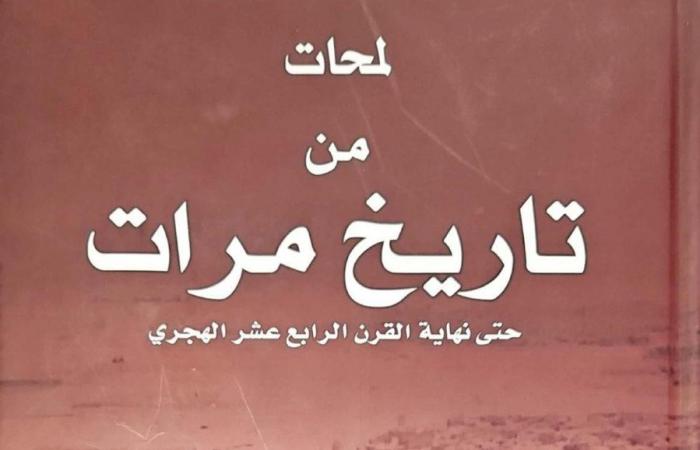Thank you for reading the news about Focus is on the Saudi environment in photo contest with SR100,000 prize up for grabs and now with the details
Jeddah - Yasmine El Tohamy - RIYADH: One of the oldest cities in Saudi Arabia’s Najd, Marat, lies tucked away in the Al-Washm region of central Saudi Arabia.
Its intriguing history is illuminated in the Arabic book “Glimpses into the History of Marat” by Saudi researcher Abdullah Al-Duwaihi, first published in 2012, yet relevant for those wishing to explore the Kingdom’s history.
Al-Duwaihi painstakingly documents the town’s geography, landmarks, social fabric, governance and centuries-old foundations across about 700 pages. The book also covers Marat’s importance on the Hajj caravan route, its scientific legacy, mosques, sports and culture, archaeological sites and a variety of other facets of society. Accounts from geographers and travelers are included.
The book opens with an overview of Marat governorate, situated in Al-Washm, northwest of Riyadh. It borders the governorates of Al-Quway’iyah and Dhurma to the south, Shaqra to the north, Thadiq and Huraymila to the east and Al-Dawadmi to the west.
Administratively affiliated with Riyadh Province, Marat oversees several centers, villages and settlements, enjoying governmental facilities and private institutions that have contributed to its development and population growth.
FASTFACTS
• When King Abdulaziz traveled from Riyadh to Makkah, one of his first official stops was Marat, where the historic Hijaz Road crossed.
• Iconic natural landmarks in Marat include Ghudair Kumait, a basin where floodwaters accumulate without stagnating.
Iconic natural landmarks profiled in the book include Ghudair Kumait, a basin where floodwaters accumulate without stagnating. It is named after the prominent Jabal Kumait landmark known for its location and form, offering panoramic views of the town. This has led to the popular adage, “Secure Kumait, and you secure Marat,” explains the author.
Along with highlighting Marat’s past, Al-Duwaihi also explores locations such as the ruins of Al-Aroosah and Al-Walidi Well, which was attributed to the Prophet Muhammad’s companion Khalid bin Al-Walid. According to historical accounts, he dug the well during his journey through Marat en route to battle the renegades in Al-Yamama.
Royal history
When King Abdulaziz traveled from Riyadh to Makkah, one of his first official stops was Marat, where the historic Hijaz Road crossed, and where he would stay for several days. Royal tents were set up outside the palace in Marat — built in 1350 AH (1930) — days in advance of his arrival.
As the royal caravan approached, telegrams were sent to prepare for essential supplies. Vehicles and caravans passing through the route would also halt in the town for rest and replenishment, transforming Marat into a bustling commercial hub, especially during the Hajj season, when it teemed with tents, vendors and shoppers lining the roadside.
The book features accounts from various travelers, both foreign and local, who passed through Marat and documented their experiences, including George Forster Sadleir, British explorer Harry Philby, American geologist Thomas C. Barger, Amin Al-Rihani, Youssef Yassin, Ahmed Al-Kadhimi and Atiq Al-Biladi. Yet he overlooked mentioning Ahmad Abdul-Ghafoor Attar, who provided captivating glimpses of the town in the 1960s.
One of the book’s notable features is its exploration of Marat’s architectural heritage, highlighting the coexistence of ancient mud-brick neighborhoods and modern structures. Although the old government palace was demolished due to encroaching modern developments, had it remained, it would have stood as a prominent landmark of the province.
Notable old quarters within Marat’s walls include Bab Al-Naqeeb, Zab’arah, Junaib, Al-Hafsiah, Banban, Hayit Hussain, Al-Shuraiqy, Shari’ah, Subaitah, Qa’rah, Suwail and Al-Naqbah. Outside the walls are Al-Qusaibah, Al-Muraiba’, Al-Ju’di, Bab Al-Naifiah, Qubaibah, Suwaydan, Al-Hulailah, Bab Al-Barr and At-Tuwaila.
According to Al-Duwaihi’s book, Al-Amiriah School was the governorate’s first educational institution, built in 1368 AH (1948). Constructed from traditional mud bricks in Marat’s northeastern quarters, the boys’ elementary school followed design templates set by the Kingdom’s educational authorities at the time.
Later, in 1387 AH (1967), the first school for girls, known as Al-Awwal School, was inaugurated, initially located in the western part of the old town before later relocating to a new governmental premises. Over subsequent years, a series of schools for both boys and girls were progressively opened.
These were the details of the news Focus is on the Saudi environment in photo contest with SR100,000 prize up for grabs for this day. We hope that we have succeeded by giving you the full details and information. To follow all our news, you can subscribe to the alerts system or to one of our different systems to provide you with all that is new.
It is also worth noting that the original news has been published and is available at Arab News and the editorial team at AlKhaleej Today has confirmed it and it has been modified, and it may have been completely transferred or quoted from it and you can read and follow this news from its main source.


